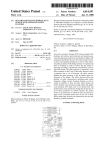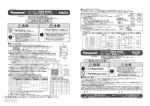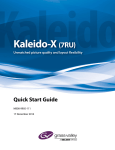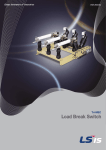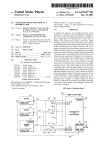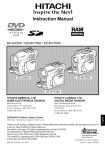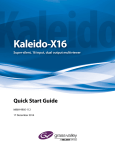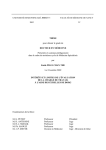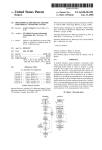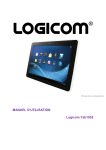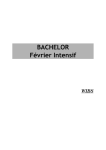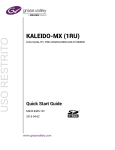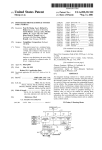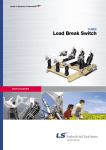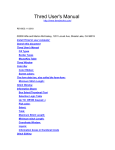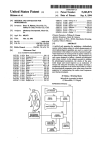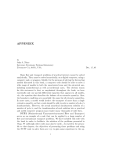Download lllllllllllllllllllllllllllllllllllllIlllllllllllllllllllllllll|l|l|||||ll|
Transcript
lllllllllllllllllllllllllllllllllllllIlllllllllllllllllllllllll|l|l|||||ll| US005474082A United StiltCS Patent [19] [11] Patent Number: Junker [45] Date of Patent: [54] 5,474,082 Dec. 12, 1995 BRAIN-BODY ACTUATED SYSTEM OTHER PUBLICATIONS [76] Inventor: Andrew Junker, 139 E‘ Davis St.’ Johnston, V. S., “Recognition of Stimulus Displays~An Electrophysiological Analysis”, Proceedings of 11th Annual Conference on Manual Control, NASA TMX-62, 464, 1975, Y°11°W Springs’ Obi" 45387 pp. 173-—178. [21] APPL No; 1,096 [22] Filed: Jan. 6, 1993 6 [51] [52] Int. Cl. ...................................................... .. A61B 5/04 US. Cl. ..................... .. 128/732; 340/825.19; 341/21; 345/157; 273/438; 123/731; 128/733; 128/905 Field Of Search ................................... .. 128/733, 905; 434/236, 323, 336, 350; 273/DIG. 28, 438, 148 B; 340/825.19, 825.24; 345/156, 157; 341/20, 21, 34 [56] References Cited U.S. PATENT DOCUMENTS 2,690,178 9/1954 Bickford . 3,032,029 5/1962 Cunningham. 3,490,439 1/1970 Rolston. 3 604 4“ 9,1971 Schuler _ 3:641:993 3,735,425 3,821,949 2,1972 Gander et aL _ 5/1973 Hoshan at at _ 7/1974 Hartzell et al. . 3,837,331 3,875,930 9/1974 Ross . 4/1975 Silva et al. . Junker, A. et al., “Loop Closure of the Visual-Cortical Response (U)”, Summary Report for Period Dec 1986 to December 1987, Feb. 1988. “A Comprehensive Treatise on Research in the Area of: Brain Actuated Conn-o1”, Sap. 17 1989' Junker, A_ et a1” “Brain Actuated Control of 3 R011 Axis Tracking Simulator’, @1989, IEEE, PP. 714-717. wolpaw, J, et 31_, “A11 EEG_baSed bfain_computer inter. face for cursor contro ”, Electroencephalography and Clini cal Neurophysiology, @1991, 78: 252259. Primary Examiner—Williarn E. Kamm Assistant Examiner-Jeifrey R. Jastrzab Attorney, Agent, or Firm—Wood, Herron & Evans [57] ABSTRACT A method and apparatus for assisting a user to control a device in response to a combination of electroencephalo graphic and electromyographic potentials. The user selects a number of reference frequencies in a range of from 0.5 Hz to 45 Hz de?ning a like number of control signals. A digital lock-in ampli?er is used with a moving average time win dow ?lter to produce control signals which are presented to 3’916’876 11/1975 Freeman _ 3,882,850 5/1975 Bailin et al. . the user. Control system responsiveness is controlled by adjusting the lengths of the movlng average time wlndows. 3,942,516 3,967,616 3,978,847 3,1976 Glynn et aL _ 7/1976 Ross _ 9/1976 Fehmi et al. . A phase-locked loop 1s closed around each control signal and is used to track the shifting frequencies of the control signals. The user is able to sense and control changes in the 3,993,213 12/1976 Price - 4’013’068 3/1977 Sam?“ 31' ' 4,031,883 6/1977 Fehrm et al. . magnitude and frequency of the control signals in the control of the device. By sensing the changes in the magnitude and - - 4 031 884 4:072:145 6,1977 Hamel 2,1978 Silva _ ' 4,149,716 4/1979 scudder _ changes in the electroencephalographic and electromyo 4,195,626 4/1980 Schweizer . graphic biopotentials are correlated to control of the device. 4,228,807 10/1980 Yagi et al. . 4,334,545 6/1982 frequency of the control signals, the user is able to learn a combination of mental and/or physical activities for which Shiga . _ 4,354,505 10/1982 Shiga. 4,375,177 _ 50 Clams, 9 Drawlng Sheets 3/1983 McCoskey . Micro?che Appendix Included (2 Micro?che, 190 Pages) (List continued on next page.) Basic Operating \33 Sym Proessor Background 39\ 3_1 Forgmumi Lon Processor Processor r Control I Signal Display Generate Generate Phase - \ Applicati Locked 34 Programs Loop \_ 43 5,474,082 Page 2 US. PATENT DOCUMENTS 4,412,547 11/1983 Callahan ‘it a1~ 4,417,592 11/1983 John ...................................... .. 128/731 4,424,816 1/1984 Callahan et a1. . 4,454,886 6/1984 Lee. 4,846,190 7/1989 John . 4,883,067 11/1989 Knispel et a1. . 4,919,143 4,928,696 4/1990 Ayers .................................... .. 128/732 5/1990 Henderson et a1. . 4,928,704 5/1990 Hardt. ‘ 4,949,726 8/1990 Hartzell m1. $51332; 3113:: 25221‘ et 81 4,967,038 10/1990 Gevins et 51.. 41595013 6,1986 Joneseta1_'_' 4,974,602 12/1990 Abraham-FuchsetaL. 4,603,703 8/1986 McGilletaL. 4,984,188 1/1991 Katq 4,610,259 9/1986 Cohen eta1.. 5,002,064 3/1991 Allam et a1- 5,038,782 8/1991 Gevins et a1. . 4,776,345 10/1988 Cohen (2131.. 4,794,533 12/1988 Cohen. 4,7()9,702 12/1987 gel-win _ 5,119,816 5,213,338 6/1992 Gevins. 5/1993 Brotz 4,800,888 5,253,724 1/1989 Itil et a1. . 273/460 10/1993 Prior ........................................ .. 180/65 US. Patent Dec. 12, 1995 Sheet 1 0f 9 L'I'u. 1 5,474,082 29 11 lOq 20\ User * User Data Basic Input Store Language 33 Devices 2% Electrodes 3 r11 .5 \ Eater 24 19\ ‘Operating Processor € Keyboard W\13 Am lifier \ ' I 31 \ _' Eaclcground lli‘dorground on? 009 :4) Processc/n;32 Processor * . . 25 System 39 = Al D , 15 \ Converter Control 41K\ Display Signal i Generator Generator \ i ’ l’. htléléices 1 17 1' 1 " Phase- \ g 37 Application Locked 34 Programs ,- Processing Loop \_ 43 arr?! “19 l l 19 JL LED Video LCD MIDI x £12 L14 j 21 t 16 ‘—|51 DIA Converter D l \ Contact 58 Interface , 55\ Music Analo Devices Synthesizer Control er 52J \60 .. Digital Controller I 563 US. Patent Dec. 12, 1995 5,474,082 Sheet 2 of 9 FIG. 2 Background Loop Initiate Every \ FIG- 3 0.01 Seconds / ‘202 Generate Control 204 Signals Foreground Loop ‘L ' 300x Phase-Locked Initialize Values Loo Enter Files S v ' ' ‘’ ' and Utilities \206 P tore Information \208 q 302 Enable Background Priority @ Interrupt Generate ~304 Displays < Menu Control >‘J 306 l i 312 314 J / Play Compose Computer Cursor Music Music Game Control Program J 308 Program / 310 Programs Programs 316 k 320 J—' 1 / Mouse Keyboard Controller Cursor and Line Interface Program Editor ‘318 US. Patent Dec. 12, 1995 5,474,082 Sheet 3 of 9 FIG. 4 Control Signal Generator Service Time Interval n " 402 1 Read Brain~Body Signal v 404 408 All Control Yes Signals Serviced? 418 1 Service N0 Compute Cosine and Sine From Lookup Tables Moving Average Window Counters \. 410 Calculate X and Y Quadrature Values from Current Sample V412 Calculate Average of 8:. Y Quadrature Values"414 Calculate Magnitu de and Phase of Control Signals / v 416 W Return US. Patent Dec. 12, 1995 Sheet 4 of 9 5,474,082 FIG. 5 ( Phase-Locked Loop ) 501 All Control Signals Serviced? 502 H NO . No \K Magnitude>Minimum’? >_ Yes Convert Phase to 0360 Degrees 506 508 504 (\ BasePhase=O prevphase=o Lockin FreqShift=O First Time Magnitude>Minimum? N0 *4 Yes BasePhase: —Phase _ I \ 510 512V Calculate Direction of Phase Shift and Update BasePhase i 514 \ PhaseChange=Phase+BasePhase PrevPhase=Phase PhaseChange 520 & \ Increment Lockin Freqshift l k. , 518 522 / Decrement Lockin FreqShif t t US. Patent Dec. 12, 1995 Sheet 5 of 9 5,474,082 FIG. 6 602 618\ 620\\ 628\ Displey 600 Musie Games 6303 F612 ) T3 Setup 610 ( K. T1 T2 (606 Cursiar Al A2 A3 B1 ‘Frequency B2 B3 B4 (607 Escape C608 Help US. Patent Dec. 12, 1995 Sheet 6 0f 9 5,474,082 FIG. 7 ( Play Music ) i es r‘ 7 01 All Control Signals Serviced? , No 702 '\ Control léngn_al\Yes Disabled? ' No First Time On ' 704 status of Off Control Signal? 706 * First Time Off 1 ‘ Yes , ‘ On Program ‘ ""‘\ Change 710 Pitch Transpose J f‘ MIDI Program Changes On Other Channels Notes Channel. Volume * 1 q Compute Volume 712 l’ 6 Disable Other Control Signals "718 \ j Tug???zgle Service Rhythm Routine Service Harmony Group "715 L Turn - Rhythm Change 714 \ Not‘e On _) Update Left/Right Pan 70s\ ,, 724 j 722 Off 0 service AS13511”8 \ 728 US. Patent Dec. 12, 1995 5,474,082 Sheet 7 of 9 FIG. 8 D1splay Music Games Cursor Setup Escape Help Games Cursor Setup Escape Help FIG. 9 Display Music FOOD FOR THOUGHT T1 T2 T3 Al A2 A3 Bl Frequency B2 B3 B4 US. Patent Dec. 12, 1995 Sheet 8 of 9 Games Setup 5,474,082 F16. 10 Display Music Upmwn A2 7 Cursor Escape Help Escape Help PINBALL E] 952 956 / 954 [21 _/ \ [I] E l _ K512] LelétgRlght I \ 958 K950 FIG. 11 Display Music Games Cursor Setup SINGLE INPUT CONTROLLER _ J 854 Up __ 856 864 Z“852 ’ 862 Down Control Opportunity B3 Wmdow Laso _. 860 51v grrélde US. Patent Dec. 12, 1995 Sheet 9 0f 9 5,474,082 FIG. 12 Display Music Games Cursor Setup Escape Help TWO INPUT CONTROLLER ,/‘882 876\ 878& ‘ I555 I51 7 I k-tsl i=3 Left/Ri m \, [B38 872 880 % "'*“886 Up/Down Override \870 FIG. 13 Display Music Games Cursor Setup Escape GAME CONTROLLER Help ' / ’ r V Z Left/R1311 F B3 892 Select; Start “ % “ r 899 UP/Down 894v A1 B Button A2"\896 A Button B2\898 5,474,082 1 2 . It has been suggested that training time can be reduced in BRAIN-BODY ACTUATED SYSTEM the alpha band by phase matching the biofeedback signal to the bandpassed alpha spectrum signal. This is accomplished by delaying the biofeedback signal by one complete cycle. This application includes a Micro?che Appendix of Computer Code comprising two micro?che that include 184 frames of computer code listing. The delay is set as a function of the predetermined dominant alpha peak frequency of the subject. This approach requires that each subject have a predominant alpha peak frequency that can be measured before training. However, one problem BACKGROUND OF THE INVENTION is that not all subjects produce spontaneous alpha. A further disadvantage is that this form of phase loop closure will only 1. Field of the Invention The invention relates generally to the area of non-manual human control of external systems. More speci?cally, the work for alpha control because theta and beta dominant peaks are not easily predetermined. It also assumes that the dominant alpha peak frequency of the subject wants to be invention provides a control system with which a user may kept constant over a session. control an external device by regulating control signals in The time varying characteristics of a bandpass ?lter response to a collective manifestation of electroencephalo output can be used to create an estimate of phase informa tion. Likewise the FFT can provide phase measures as well as magnitude measures. Thus phase information can be used as a feedback signal as well as magnitude. However, other graphic and electromyographic biopotentials. The invention further provides the capability for the user to play music and games and create visual art as training aids for improving system control and for entertainment and relaxation. 2. Summary of the Related Art Through the years there has been signi?cant research in the area of detecting and observing various electric poten tials generated within the human body for medical diagno sis, biofeedback control of mental and physical states, and control of external devices. In that work, it is well-known to 20 than the attempt to create phase matching to an alpha peak frequency as discussed above, there are no instances in the prior art in which use of phase information is successfully incorporated into a biofeedback paradigm. The contraction of skeletal muscle is preceded by a 25 sequence of rapid changes in the muscle nerve ?ber mem brane potential. This sequence of potential changes is called detect on the outer surface of the head electroencephalo an action potential. Each time an action potential passes along a muscle ?ber a small portion of the electrical current spreads away from the muscle as far as the surface of the intensities of the brain waves or EEG on the surface of the 30 skin. If many muscle ?bers contract simultaneously, the summated electrical potentials at the skin may be great. scalp range from zero to 300 microvolts, and their frequen cies range from once every few seconds to 50 or more per These summated electrical potentials are referred to as second. Much of the time, the brain waves are irregular, and electromyographic biopotentials (EMG). no general pattern can be discerned in the EEG. However, at EMG biopotentials have also been detected and used for other times distinct patterns are present. For classi?cation various forms of medical diagnosis and biofeedback control. purposes, the EEG has been divided into a number of Strong EMG biopotentials are usually considered to occur in frequency spectrums. These frequency spectrums can be a range of approximately 100 Hz-3000 Hz; but since the classi?ed into ‘alpha’ (8 Hz to 13 Hz), ‘beta’ (14 Hz to 50 EMG is the summation of numerous action potentials, EMG Hz), ‘theta’ (4 Hz to 7 Hz), and ‘delta’ (below 3.5 Hz). biopotentials will occur below 100 Hz as well. Therefore, Activities within the various EEG spectrums have been 40 EMG biopotentials contain frequency components between correlated to states of sleep, relaxation, active thought, etc. zero and 100 Hz. EMG biopotentials are typically detected Depending on :he nature of the activity of interest, it is at the site of muscle activity, for example, at the jaw to well-known to detect EEG waves at different areas on the monitor jaw tension or around the eyes to detect ocular scalp as a function of the part of the brain of interest. muscle activity. EMG biopotentials may be detected for By providing a feedback: of EEG biopotentials in a 45 medical diagnostic purposes in which a patient observes graphic (“EEG”) biopotentials or brainwaves which dem onstrate continuous electrical activity in the brain. The particular EEG spectrum, a subject may be trained to empha their own muscle tension as a biofeedback signal. In addi size or de-emphasize an activity associated with that EEG tion, EMG biopotentials may be detected for the purposes of spectrum thereby reinforcing or diminishing the mental and physical state associated therewith. Further, work has been done with a subject to provide a feedback of EEG activity in a particular spectrum, for example, the alpha spectrum of 8 Hz-l3 Hz. Using that feedback, the subject learns to control the magnitude of the alpha spectrum to energize a switch or other external device. In other work, through training, a subject is able to generate an alpha biopotential in response activating a switch mechanism to control an external device. Even though EMG biopotentials are somewhat easier to 50 control because they are produced by a physical activity, any use in the prior art work of EMG signals is in response to an averaged magnitude over a spectrum centered at 100 Hz or more. That averaged magnitude is used to control a single activity or switch. Therefore, a limitation of traditional EMG A disadvantage in all of the above work is that one signal processing is only a single channel of control. Most of the prior work makes extraordinary e?forts to work with signals representing either pure EEG biopoten measurement site produces only one control. Using multiple tials or pure EMG biopotentials. In the examples of EEG to an external stimulus. bandpass ?lters or a Fast Fourier Transform algorithm (FFI‘), the EEG is divided into a number of frequency spectrums. By employing these techniques, users have been able to work with the time varying EEG spectrum magni tudes. While pure EEG signals may be divided into a number of frequency spectra correlated to mental states, it is very di?icult to learn to control those spectra and mental states and to maintain such control over time without extensive practice. 55 work, the detection and processing of EEG biopotentials in the range of approximately 0.5 Hz—35 Hz includes process ing to reject EEG when it contains artifacts of EMG biopo tentials. One approach is to inhibit the production of the feedback signal if an undesirable attribute appears in the EEG biopotentials. Another approach is to obtain a multi plicity of EEG and EMG signals and inhibit feedback when any of the EMG signals exhibit undesirable characteristics. There is a potential problem in using an inhibit approach to 5,474,082 3 4 deal with an artifact. If a subject simultaneously produces the correct EEG response while producing an inappropriate EMG response, inhibition provides an ambiguous feedback user selects a number of reference frequencies in a range of cue. In that case, the absence of feedback due to inhibition control signal is processed by a digital lock-in ampli?er consisting of two quadrature phase detectors. The digital selectable frequencies of from 0.5 Hz to 45 Hz which de?ne a number of control signals in the control system. Each suggests to the subject that they are not producing the appropriate EEG response when in fact they are. Other approaches that attempt to deal with artifacts lock~in ampli?er samples the ?ltered input signal and peri odically computes X and Y quadrature values at the lock-in reference frequencies of the control signals. Time averaged include: providing subjects with a cross-hair ?xation point to limit eye movements, making EEG measurements as far X and Y quadrature values at the lock-in reference frequen cies are periodically computed by lowpass ?ltering the X and Y quadrature values through moving average time away from potential EMG sources as possible, for example, the occipital and parietal regions of the scalp, and the sensing of and subtraction of the comeoretinal potential Windows. The time averaged X and Y quadrature values are from the EEG. All of these approaches have inherent dis tude and phase values at the lock-in frequencies. The user converted to polar form by periodically computing magni advantages. They either provide ambiguous or false feed controls the length of the moving average time windows back cues, require a multiplicity of measurement sites, or thereby controlling the responsiveness of the control system. The digital lock-in ampli?er is extremely effective in detect ing periodic signals of low amplitude with a poor signal to they reject the potential usefulness that might be gained by the simultaneous presence of both the EEG and EMG biopotentials. Therefore, even though there has been sig ni?cant work with EEG and EMG biopotentials for several decades, there have been few practical results. 20 SUMMARY OF THE INVENTION noise ratio. The control system uses a phase-locked loop around each lock-in ampli?er to track frequency changes of the reference frequencies of the control signals. This tracking of frequency is driven by the changing phase measures obtained by the with which a user may control a device by regulating a lock-in ampli?er. An average of the phase of each control signal is computed and used to indicate when the current average phase is leading or lagging a base phase established for each lock-in frequency. A constant phase difference plurality of control signals in response to a user presentation of the characteristics of an aggregate of EEG and EMG frequency. A changing phase difference indicates that the To overcome the limitations of current systems, a primary object of the present invention is to provide a control system biopotentials and feedback of the operation of the device. According to the principles of the present invention, an aggregate of the EEG and EMG biopotentials from the user is processed by a digital lock-in ampli?er in a phaselocked 25 between two signals indicates that they are at the same 30 lock-in frequency increases, indicating that the control sig loop to produce control signals, the magnitude and phase of which may be selectively employed by the user to control devices. The use of an aggregation of EEG and EMG biopotentials is an important feature of the invention. For electrodes placed on the forehead, the invention detects surface bio potentials resulting from both the EEG and EMG. Investi gations with the invention have con?rmed the hypothesis nal is lagging the lock-in frequency, the lock-in frequency is 35 ferent and separately detectable frequency spectral charac~ decreased to match or track the decrease in control signal frequency. Likewise when the phase difference increases negatively indicating that the control signal frequency is speeding up relative to the corresponding lock-in frequency, the lock-in frequency is increased to track or follow the increasing frequency of the control signal. In this way, the invention is able to track and follow the changing frequency shifts of each control signal. The magnitude values and shifting frequency values of that the EMG measured at the forehead is actually a sum mation of biopotentials from a number of muscle groups such as the eye, frontalis, neck, jaw, etc. Further, that the contributions from the different muscle groups exhibit dif two signals may be at different frequencies, and this property is used to create the phaselocked loop. When the phase difference between a control signal and the corresponding the control signals are presented as feedback to the user. The 45 teristics in the 0.5 Hz to 45 Hz range when using the user is able to sense the magnitude and frequency changes in the control signals in response to changes in the EEG and EMG biopotentials resulting from the user’s activity. In this invention. Further, that these diiferent spectral characteris way, the user can produce desired control actions with the tics can be consciously controlled. This ability to control and detect separate muscle groups with the invention, allows invention by guiding the changes in their control signal magnitudes and frequency shifts. immediate user access to multiple controls from one mea surement site. The control system has an advantage of using a single measurement site to produce multiple control signals pro The derivation of multiple controls from the presence of viding the user with extensive capabilities, such as, multi channel, or multi-axis control of devices, the ability to play the EMG as well as the EEG at one measurement site, distinguishes the invention from past approaches. In contrast 55 to the prior art, therefore, the invention does not attempt to process either pure EEG related biopotentials or pure EMG related biopotentials, but instead processes a signal derived from an integral combination of both biopotentials. To those capabilities are achieved using a single input channel and signal with minimal connections and interference with the user. distinguish the invention from classic EEG signal processing and classic EMG signal processing, the aggregate of EEG biopotentials and EMG biopotentials used by the claimed Because the invention makes use of both the EEG and EMG manifestations in the brain-body signal, the user may control the mix of the two signals; and the control system has an advantage of responding to users of all levels of invention will be de?ned for purposes herein as a brain-body signal. The control system ?rst processes the brain-body input signal to produce a ?ltered input signal which changes in response to changes in the EEG and EMG biopotentials. The an electronic musical instrument or video game, the ability to move a cursor about a video display screen, etc. Further, control ability. The magnitude and frequency feedback of 65 the control signals to the user include audio and video presentations in user selectable formats. Feedback training paradigms are available to aid in user training. With the 5,474,082 5 6 control system, a user quickly becomes aware of their FIG. 9 is a drawing of a graphical display for the training game Food For Thought. FIG. 10 is a drawing of a graphical display for the training game Pinball. FIG. 11 is a drawing of a graphical display for multi-axis connection to the control system and experiences an imme diate sense of control through conscious body movements, such as eye movement, jaw tension, deep breathing, etc. In only a few minutes or less, the user is able to consciously direct the control signals which have been generated from the brain-body signal and fed back to the user. With time, users exhibit more subtle control, using smaller amplitude control using a single control signal. FIG. 12 is a drawing of a graphical display for multi-axis control using two control signals. brain-body signals as they begin to minimize the energy required to accomplish magnitude and frequency loop 10 closure and system control. As the user becomes more FIG. 13 is a drawing of a graphical display for a video game controller. pro?cient, the control system is able to provide the user with expanded and more complex capabilities. Thus, the control DETAILED DESCRIPTION system has the advantage that the user should never expe A system schematic diagram of the control system of the invention is presented in FIG. 1. A user 10, for example, a rience limitations in the control system’s ability to respond to their most subtle inputs. human, interacts with the control system 29 through control There are several advantages to using the lock-in ampli ?er technique. Magnitude and phase values about each of the control signal lock-in frequencies of interest may be quickly computed, thereby permitting the responsiveness of each of their brain-body signal detected by electrodes 22, through 20 other input devices 20, such as a keyboard 11, mouse 13, or voice activation 15, and through information fed back to the user from output mechanisms 21, such as, by audio and measure to be individually adjusted. If the time between visual means and the operation of devices. The input signals when a user generates a signal and when the user receives a from the input devices 20 are connected to a microprocessor processing unit 30 by means of input interfaces 17. Once the system is set up for a user, their brain-body connection may measure of that signal is too long, the user will not experi ence a sense of connection with the feedback device. Signals in the theta band change more slowly than signals in the alpha band, which change more slowly than signals in the beta band. The invention accommodates those variations by permitting different values of responsiveness to be set for 25 brain-body signal is preferably detected at the forehead, however other locations may be used. Preferably, three each control signal. Proportionally decreasing responsive ness in the lower frequency band provides an additional 30 bene?t of increasing the frequency selectivity in those bands where it is needed. Another important capability of the lock-in ampli?er as incorporated in the invention is the ability to change a control signal lock-in frequency at any time and indepen dently of the other control signal lock-in frequencies. In be the sole operative input to the control system. Thus the invention can be used by diiferently abled people. The electrodes which include two signal lines and a neutral line are attached to the forehead of the user. The physical relationship of the two signal electrodes to the neutral or ground electrode is a function of the application of the system. For example, the neutral may be placed at a position contrast to other signal transform techniques, such as FFT, between the other two electrodes. This con?guration has been found to provide the best sense of balance by users for most loop closure activities. The preferred electrodes are not standard EEG electrodes a lock-in frequency can be shifted up or down any amount at any time. The invention makes use of this capability to input. But instead, the preferred electrodes have a larger 35 which have a relatively small surface area for more localized create phase-locked loops about each of the brain-body surface area, for example, electrocardiographic (“EKG”) control signals. electrodes, which will pick up more of the EEG potential. Therefore, the signal will not be localized but will contain These and other objects and advantages of the invention will be apparent to those skilled in the art in light of the more signal averaging. The three electrodes are mounted at selectable positions in a head band. When worn by a user the electrodes are applied to the forehead. The electrodes may present disclosure including the accompanying drawings, the detailed description of the invention and the appended be silver/silver chloride hydrogel disposable electrodes designed for resting EKG use, commercially available from NDM. As will be appreciated, a supplemental tube gel may claims. BRIEF DESCRIPTION OF THE DRAWINGS FIG. 1 is an overall block diagram of the control system of the invention. 50 be used to reduce the electrical resistance of the junction between the electrode and the user. The ampli?er and ?lter system 24 ampli?es the brain body signal output from the electrodes. The ampli?er and ?lter system has a gain of approximately 50,000 and pro FIG. 2 is a ?owchart of a process for executing the background loop program of the control system. FIG. 3 is a ?owchart of a process for executing the 55 vides a bandpass ?lter with a bandwidth of approximately 0.5 Hz to 45 Hz. The ampli?er may be a Grass model P5 foreground loop program of the control system. series A.C. pre-ampli?er and Grass RPS107 power supply. FIG. 4 is a ?owchart of a process for generating control The ?lter may be a KrohnI-lite model 3750 bandpass ?lter. signals. FIG. 5 is a ?owchart of a process for executing a phase~locked loop program to adjust the phase of the control signals. The ampli?ed and ?ltered brain-body input signal repre 60 senting an aggregate of EEG and EMG biopotentials is connected to an analog to digital (“A/D”) converter 26. The connection to the A/D converter 26 may be solid wires with electrical isolation means, infra-red transmission, radio control signal display. transmission or any commercially available serial bidirec~ FIG. 7 is a ?owchart of a music program and MIDI code 65 tional communication link. An AID converter such as model FIG. 6 is a recreation of a brain-body time history and generation routine. FIG. 8 is a drawing of the musical player/trainer display. ADA 1100 commercially available from Real Time Devices may be used. The AID converter 26 contains an internal 100 5,474,082 7 8 H2 clock which is used to sample the analog brain-body signal at a rate of 100 samples per second. The digital brain-body signal is stored in data store 19 with each sample. independent processor, and the foreground simply reads the computed values as required. When the control system is turned ON by the user, the foreground loop of FIG. 3 is entered. The program at step The brain-body signal processing may be accomplished within a commercially available personal computer having a processing unit 30 comprised of a 386 Intel processor and 5 math coprocessor with a 33 MHZ clock. Operating system 300 ?rst initializes values and reads the required ?les and utilities. The default values for ten reference frequencies are in a predetermined range of from 0.5 Hz to 45 Hz, and those 31 is comprised of software programs including the standard DOS based operating programs and BASIC language pro ten reference frequencies de?ning the control signals are read from data ?les. At step 302, the foreground loop processor enables the priority interrupt for the background cessor 33. Other programs within the operating system 31 10 also include a background loop processor 35 and a fore loop processor thereby permitting a background loop inter ground loop processor 39 which are unique to the control rupt generated every 10 milliseconds at step 202 of FIG. 2 system of the claimed invention. The background loop processor 35 reads the brain-body signal from the A/D converter 26 and uses a digital lock-in ampli?er provided by control signal generator program 32 to produce control to interrupt the foreground loop. With each interrupt, a lock-in ampli?er is used to determine the magnitude and phase values for each control signal at step 204. At step 206, a phase-locked loop is used to determine changes in the signals at reference frequencies the user has chosen from a phase of the control signals, and the phase changes of the control signals are used to change the reference frequencies. range of selectable frequencies. Next a phase-locked loop program 34 [forms a phase-locked loop for each control The ?nal step 208 of the background loop program is to store these values for future use by the foreground loop processor. signal. The phase-locked loop permits the control system 29 to track the predominant frequencies of the brain-body Upon completion of the background loop processor, the signal within each selected control signal reference fre quency band. Generation of the control signals and the phase-locked loop are controlled by the same 100 Hz clock that controls the A/D converter 26. Gain and responsiveness of the control system are selectable by the user via the user control signals are fed back to the user via audio and/or video presentations, step 304 of FIG. 3. Via feedback presentations of control signal magnitudes and reference 25 frequencies, the user is able to sense how changes of EEG and EMG biopotentials effect the control signals. The input devices 20. The processing unit 30 transmits data between it, the operating system programs and the data store response of the user determines the ?ow through the remain over an internal data bus 41. der of the foreground loop. Once entered, the foreground loop processor 39 continuously loops back to the display A display generation program 37 within the foreground loop processor 39 uses the brain-body signal and generated magnitude and phase signal values computed from the last step 304 which updates the user presentations based on the control signals as a basis for the presentation of various audio and visual feedback to the user. Depending upon the task being performed by the user, different visual displays may be incorporated, for example, a video display terminal 14, an LCD display 16, or an LED display 12 may be used. Further, the foreground loop processor 39 permits the user interrupt. The user is then able to control functions of a 35 device in response to the control signals. More speci?cally, using menu displays, the user modi?es the performance of the control system during each iteration of the foreground loop processor. The user chooses whether to execute a play music program 308, a compose music program 310, a input devices 20, such as a mouse or keyboard, to be used computer game program 312, or a cursor control program to select various application programs 43 for execution. 314. Under the cursor control program 314, the user can User application programs include a play music program, a 40 choose to work with the mouse program 316, a keyboard] compose music program, computer game programs, cursor line editor program 318, or the controller interface 320. control programs and mouse programs. The data store 19 The play music program 308 permits the user to play stores data associated with the execution of programs within music on an electronic musical instrument with control the background loop processor 35 and foreground loop signals in a manner similar to using ?ngers on a keyboard. processor 39. External devices 55, such as a wheel chair, 45 As the user plays the music and senses, by sight and hearing, cursor control, music synthesizer, a sailboat, etc, can be the control signal presentations and the notes being played, connected to the control system 29 and operated by the the user is able to become aware of the relationships between control system via a contact interface 54 and associated the sensed characteristics of the control signals and their switch closures within a digital controller 56 or a digital to brain-body activity. Additionally, the user is able to learn analog converter 58 and an analog controller 60. The pro cessing unit 30 communicates with the devices 55 and about music from the displays. While playing music, the user can also choose to display a kaleidoscope which output devices 21 over an input/output bus 57 which may be an expansion bus typically found in personal computers. FIGS. 2 and 3 illustrate the two principal processing loops executed by the software in processing unit 30. The back ground loop processor of FIG. 2 is a time dependent priority interrupt processor and is executed every 10 milliseconds presents a changing colored pattern. The turning ON and OFF, screen location and assignment of color attributes to the display pixels corresponds to the control signal magni 55 tude and phase values. Playing music has the bene?t of providing the user with a rich and pleasing audio biofeed back training paradigm. A compose music program 310 The time of execution may be controlled by an external or internal clock and preferably is driven by the same 100 Hz clock that controls the sampling of the A/D converter 26. permits the user to compose new music. Music may be The foreground loop processor of FIG. 3 is not time depen dent. The foreground loop can be incorporated into the of interest. Examples of this include such capabilities as learning to increase alpha or theta band activity while lowering beta band activity. Since the user simultaneously receives biofeedback information about brain and body activity, the control system permits the user to explore the composed speci?cally to aid the user in the exploration of their brain-body connection in designated frequency bands background loop resulting in both programs being executed once every 10 milliseconds. In the disclosed embodiment, the foreground loop continuously executes while the back ground loop interrupts every l0 milliseconds. In other embodiments, the background loop may be executed by an 65 relationship between body biopotentials, EMG, and brain biopotentials, EEG, in these bands. 5,474,082 9 10 Computer game programs 312 may be played with the embodiment, up to ten control signal frequencies may be selected and computed. The selected frequencies of the control signals are speci?ed in terms of harmonics of the fundamental frequency, as follows control system of the invention. As well as being entertain ing and challenging, the games provide opportunities for the user to learn to work with the control signals derived from their brain-body signal. The ability to consciously regulate one control signal coupled with an opportunity window display, to be subsequently described, or the conscious Cfi HF'ZT regulation of two control signals simultaneously permits the user to interface with the cursor movement programs 314 where and mouse cursor programs 316. With the mouse cursor capability, the user is able to access the control signal actuated keyboard and line editor routines 318. The same approach that is used for cursor control in the control system is used in the controller interface program 320. The ways in which controls signals are used for multiaxis control and the implementation of an opportunity window to achieve mul tiaxis from one control signal are discussed below. FIG. 4 is a ?owchart of the control signal generator program executed at step 204 of FIG. 2 of the background loop and illustrates a process for generating control signals from sampled brain-body signals. The brain-body signal Cf,=frequency of the current control signal being pro cessed, Af= fundamental frequency, and i=i,,, control signal. The speci?c sine and cosine table position p from which sin and cos values are to be read is determined by where 2O sample times, for example, once every 10 milliseconds, using the 100 Hz clock within the AID converter to produce sampled input signals. Consistent with frequency sampling theory, the sample rate of 100 Hz is more than twice 45 Hz, fsi=frequency shift from Phase-Locked Loop routine block 520 or block 522, and Phsi=previous table position, updated each time a new output from the A/D converter 26 is sampled at successive frequency shift is requested by the phase-locked loop. 25 if p<N, then operating within ?rst harmonic and may go directly to table position p; but if p>N, then must extract the number of harmonics as follows: the highest brain-body signal frequency of interest. The control system generates a time history for each control signal by averaging the quadrature values of each control signal over respective moving average time windows. To calculate the quadrature values of the brain-body table positiom p = n; H,- — [ integer of ni ( signal required to implement the digital lock-in ampli?er, sine and cosine values must be determined over a range of Each time a shift in the lock-in frequency of a control from zero degrees to 360 degrees. The control system utilizes a table of sine and cosine values to increase the 35 processing speed. To implement the table, one cycle of a full signal is requested, the phase shift value is assigned the previous table position value; and the time based index is reset to n=l. Resetting the time based index and de?ning a sine wave has been divided into N increments; and sine and cosine values for each of the N increments is stored in the table. The increment size of the table is used to de?ne the new phase shift value creates a smooth transition from one lockin frequency to the next. angular resolution, that is, fundamental frequency, of the control system. A value of N=l600 increments has been arbitrarily chosen to reduce memory storage requirements for the table. Given a sample rate of 100 Hz, or 10 milli seconds, this results in a fundamental frequency, Af=0.0625 Hz. The sin and cos values for each table position are 45 computed and stored during the initialization phase, step 300 At step 410, using the above, sin and cos values for the lock-in frequencies of the control signals at the current time based index are read from the table. Using those sin and cos values, the X and Y quadrature values at the lock-in fre quency of the control signal being processed are computed for the current sample of the brain-body signal at step 412, as follows: of FIG. 3 as follows: Xquad,=(bb,.)(c0s,) Yquaa?bbnXsinp) table cos,I = COS 21: ( a) table sin” = SIN 211: ( lN ) where bb,,=brain-body signal at the current index, and sinp, cospqine and cosine table values. 55 N :Maximum table size, and n =current value of a time based index from 1 to N. Next, at step 414, the average values of the X and Y quadrature values are computed. First, the X and Y quadra The control signal generation program of FIG. 4 begins ture values are added to respective X and Y moving average with the servicing of a time index n at step 402. The index time window ?lters. The user is able to adjust control system is incremented by one with each iteration up to a cumulative 60 responsiveness for each control signal to match the user’s value of N, or 1600 iterations. After N iterations, the index perceptions. That adjustment is made by the user selecting is set back to one. With each iteration, the sampled digital the lengths of the moving average time windows in a range brain-body signal is read at step 404 of FIG. 4 and held in of from 50 samples to 300 samples. The length of both the X and Y moving average time windows is the same and is At decision step 408, an internal counter permits steps 65 adjusted in unison. Given a 100 Hz sample rate, the range of 410-416 to iterate a number of times equal to the number of adjustment of the moving average time windows represents control signals selected by the user. With the disclosed a bandwidth about the center frequency of from 2 HZ to 0.33 a buffer store. 5,474,082 11 12 Hz. Therefore, if the user selects a more responsive system, previously discussed, the lengths of the time windows may be adjusted by the user; and the control system monitors the user settings and adjusts the length of the moving average time windows at step 418. the control system reduces the length of the moving average time windows by reducing the number of samples in the windows. As the system becomes more responsive, the lock-in frequency bandwidth increases; and the control The lock-in ampli?er approach permits different window system has less resolution about the selected lock-in fre quency. Alternatively, if the user selects a less responsive lengths for each control signal. If the user does not choose to change these values, the invention defaults to values that system, the control system lengthens the moving average time windows by increasing the number of samples in the have been chosen to improve high frequency responsiveness windows. With a less responsive system, the bandwidth about the lock-in frequency decreases, and the control system has greater resolution about the selected lock-in frequency. At step 414, for each of the X and Y moving average time window sums, the oldest X and Y quadrature values are subtracted from their respective sums, and the new X and Y values are updated and added to their respec tive sums. The average X and Y quadrature values are then calculated by dividing each of the X and Y quadrature sums by the size of the time window, that is, the total number of samples used for averaging as determined by the respon siveness selected by the user. Therefore, the X and Y and low frequency selectivity at the same time. Window 10 widths relative to the center or 5th lock-in frequency are de?ned at the start of the program as follows: After the control signal magnitude and phase values have been determined, the phase-locked loop, step 206 of FIG. 2, of the background interrupt routine is executed. Referring to 20 quadrature average values are calculated as follows: 25 FIG. 5, the phase-locked loop program must be executed a number of times equal to the number of control signal frequencies selected by the user. Therefore, at step 501, the process checks to determine whether all the control signals have been serviced. If not, at decision step 502, the process determines whether the magnitude of the control signal being considered is greater than a user de?nable minimum value. If not, the base phase, previous phase, and lock-in frequency shift values are reset to zero, at step 504, in preparation for when the magnitude does exceed the mini mum. A minimum magnitude test is preferred to eliminate 30 those signals which cannot be distinguished from noise, and the phase-locked loop routine will only process control signals having a magnitude greater than the minimum. Typically, an acceptable minimum signal magnitude is at least 5% of the maximum signal magnitude. In the absence 35 of a user selection, the minimum is defaulted to 5%. If the control signal is greater than the minimum, the phase for that control signal is adjusted to a range of between 0 degrees and 360 degrees per step 506. It should be noted where W,=size of the in, time averaging window, and W,~1',,, time average window index from 1 to W,-. that the calculated X and Y quadrature values are vector 40 be used to identify in which quadrant of a 360 degree unit circle the vector is located. The :90 degree phase values, The user also has the ability to set and adjust the value of a gain to be applied to each of the control signals, and those control system gain values are stored. At step 416, the stored control signal gain values and the averaged X and Y quadra which were determined at step 416 of FIG. 4, may be used to de?ne the speci?c vector location in the identi?ed quad 45 rant. 50 If this is the ?rst time that a control signal is greater than the minimum, the lock-in frequency phase is matched to the control signal phase. At step 510, a base phase, which is a reference phase, is established by setting its value equal to the negative of the present phase value of the control signal for the current sample of the input signal. For the ?rst time processing of that control signal, the remainder of the routine of FIG. 5 provides no additional processing. There fore, with the ?rst iteration, the control signal being pro ture values are used to compute time averaged magnitude and phase values of the brain-body signal corresponding to the control signal lock-in frequencies being generated for the current sample of the brain-body signal as follows: Ynvgi phase,- = aretan X quantities. Therefore, the signs of the quadrature values may 55 3i cessed by the phase-locked loop is brought into phase with detected by decision block 408, the moving average time the current phase of the brain-body signal at that lock-in frequency. During a subsequent iteration of FIG. 5 in the processing of another sample of the input signal, if that control signal has a magnitude greater than the minimum, the process moves through step 508 to step 512. At step 512, the direction of phase change from a previous phase value to the present phase value is determined. The control system assumes that the direction of phase change is de?ned by the minimum path, that is, the shortest distance around a 360 degree unit circle, in moving from the previous to the present phase values. If the minimum path is de?ned window counters are serviced at process step 418. As by counterclockwise movement around a 360 degree unit where G,=user selected gain for i,,, control signal 60 Even though the arctangent function is recited, other iden tities may be used to de?ne the phase. It is typically de?ned in a range of i90 degrees. After the magnitude and phase values for all the control signals have been evaluated for the current time index, n, as 65 5,474,082 13 14 circle, the current phase value is assumed to be lagging the control signal, and the length, or height, of the bar represents the magnitude of the respective control signal. The system previous phase value. Conversely, the current phase value is interpreted as leading the previous phase value if a clock wise movement results from the minimum path. If the provides the user with up to ten frequency spectra, three in minimum path results in crossing the 0/360 degree point of the theta, three in the alpha and four in the beta frequency range. The theta bands are displayed in blue, the alpha bands a unit circle, the base phase value is adjusted by adding or subtracting 360 degrees according to whether the current in green and the beta bands in red. While the control system phase is lagging or leading, respectively. colors of the bands shift in color shades to indicate to the user the up and down shifting of the lock-in frequencies as At step 514, a phase change of the current phase value relative to the base phase value is computed by algebraically adding the current phase value to the adjusted base phase value. The phase change represents a difference between the base phase value and the current phase value. Further, the previous phase is set equal to the current phase value in preparation for the next iteration. At step 518, the phase change value of the current control signal is tested to determine whether the "current control signal is lagging or leading the base phase value of the is running and the phase-locked loop is functioning, the 10 two slide controllers 624 and 626 which allow the user to 15 window 625 and the gain slide controller 624, the user is signals. Using the control signal selection window 627 and the response slide controller 626, the user can tune the 20 detected to be greater than a predetermined arbitrary mini mum amount, for example, i 45 degrees, a frequency change of the lock-in reference frequency of the control signal is initiated. This is accomplished by incrementing or decrementing a frequency shift at steps 520 and 522, respec tively. If the control signal is leading as indicated by the adjust gain and responsiveness, respectively, of all or any selected control signal. Using the control signal selection ' able to change gain values for all or any all of the control current control signal by a predetermined arbitrary minimum amount, for example, i45 degrees. If the phase change is they follow the frequency shifting of the user’s control signals. The screen 604 also displays the time history 614 of the user’s brain-body signal. The screen 604 further displays responsiveness of the system to match the characteristics of the tasks being performed. For example, the playing of video games usually requires a high degree of responsiveness and less selectivity, while the playing of certain musical pieces wants a higher degree of selectivity and a slower responding 25 system. Using the mouse or keyboard devices 20 of FIG. 1, the phase change value being more negative than ~45 degrees, user can access the various menu selections. The display the lock-in frequency is incremented at step 520 to cause the lock-in frequency to be shifted up to catch-up to the control menu 618 allows the user to select various time history signal. A positive value of phase change greater than 45 degrees indicates that the control signal is lagging the displays such as the brain-body signal illustrated, control 30 The music menu 620 allows the user to select the compose reference value, and the lock-in frequency is decremented at step 522. Preferably the lock-in frequency is shifted up and down in multiples of a predetermined frequency increment, for example, the fundamental frequency, Af. The lock-in frequency shift is accomplished at step 410 of FIG. 4 by assigning the phase shift value the immediately prior table position value, and resetting the time based index to n=1. Resetting the table position and de?ning a new phase shift signal magnitudes, control signal phases, etc. music routine or the play music routine of FIG. 7. The play music routine presents a ?rst screen having displays similar to FIG. 6, that is, a time history of the control signal and bar 35 graphs with on-olf musical switches included. The play music musical routine also provides a training screen 802 illustrated in FIG. 8, and a kaleidoscope display, not shown. The game menu 628 permits the user to select and play training games. The cursor menu 630 allows the user to value creates a smooth transition from one lock-in frequency 40 either work with the mouse cursor, use the cursor controlled to the next. As will be appreciated, other phase change tests may be implemented. For example, a test may be made to determine whether the phase change di?fers from the base phase value by 90 degrees, 135 degrees, etc., and the lock-in frequency shifted by appropriate multiples of the fundamen tal frequency. keyboard and line editor, or work with the controller inter face for the control of external devices. The setup menu 606 allows the user to customize the control system to individual needs. One setup menu selection allows a control mode in 45 signals generated by the brain-body signal. In this way, A phase-locked loop can also be employed with an FFI‘. However, with the FFT, the ?mdamental frequency is inversely related to the responsiveness of the algorithm. Thus, to obtain responsiveness comparable to what is pos sible with the lock-in ampli?er, would result in frequency which the control system may be setup in response to control differently abled users can be initially setup by an attendant and then left on their own with the invention. Within the setup menu, the default values of the control signal reference 50 frequencies may be changed. Since the system is digital, the selection and modi?cation of control signal frequencies is steps of no less than 0.78125 Hz (based upon a 128 point based on discrete increments de?ned by a fundamental transform and a 100 Hz sample rate). Therefore, the equiva frequency. Further, as with any frequency responsive or resonant system, to fully exploit the capabilities of the control system, the selection of the control signal frequen cies should consider the in?uence of harmonic relationships between chosen frequencies of the control signals. The lent FFI‘ phase-locked loop can not function at as ?ne a level as is possible with a lock-in ampli?er based phase-locked 55 loop. Usually, no more than four steps up or down are needed to create an effective phase-locked loop. The shift in the lock-in phase is fed back to the user through visual and frequencies should be chosen so that the control system audible displays as will be hereinafter described. signal processing minimizes the ?rst order harmonic distor FIG. 6 illustrates the primary screen of the invention by which the control signals are presented to the user by being displayed on video monitor 14 of FIG. 1. User interaction is provided along the top area 602 of the screen 604 which tions. Therefore, the above considerations may impose some constraints on the selection of control signal frequencies and the separation between selected frequencies. Those con straints may be implemented as defaults in the control contains various pull—down menus. Below the menu area are simutaneously presented as a series of bar graphs on a system or may be overridden by the user. The escape menu 607 allows a user to retum to a previous display or program status at any time. The help menu 608 provides access to a graphic display 600. Each bar 612 represents a selected user’s manual. 602, the control signals derived from the brain-body signal 65 5,474,082 15 16 Once computed, the magnitudes and frequency shift val the composing process, as are channel volumes. Rhythm in the form of note accenting can be speci?ed for selected ues of the control signals provide feedback links between the user, the control system program and any associated devices. By controlling these values, the user controls the system. To make use of the changing magnitude levels, user selected predetermined ON and OFF switch levels are de?ned for control signals as part of the composing process. The frequency shifting values computed by the phase-locked loop routine can be used by the composer to control pitch transposing, rhythm shifting and stereo panning. each control signal. The ON and OFF switch levels represent As part of the composing cycle the composer speci?es which control signals will make use of the frequency shift information. To bring further direction to a piece, the capa predetermined control signal magnitudes which are e?fective to control functions on external devices. When the user causes the magnitude of a control signal to exceed the associated ON switch level, the control system responds bility of commanding program changes when a control signal switches ON is also included. Such program changes with an appropriate function. In the music program, for example, this may result in a note being turned ON; or if the can be speci?ed with this capability by the composer. as changing voices on other control signal related channels note is already ON, the volume tracking the magnitude of the control signal. Alternatively, the cursor control program A simple format is followed to write a song and enter it 15 may use the control signal switch to direct cursor movement in a desired direction or to effect a switch closure associated with the operation of an external device. When the user causes the control signal magnitude to be equal to or less than the OFF switch level, generally the opposite function is the invention. Once a user selects a song to play, playing the 20 selected song really means playing a synthesizer through 25 control of their brain-body signal. Playing the synthesizer by changing the individual control signals of their brain-body signal is analogous to playing the keys on the keyboard of the synthesizer. A play music routine is presented in ?ow diagram form in initiated. For example, a note is turned OFF, a switch is opened, etc. Although different control signal magnitudes for the ON and OFF switch functions are preferred, the ON and OFF switch functions may be achieved by determining whether the control signal magnitude is greater or less than a single predetermined switching level. The shifting of the control signal lock-in frequencies may FIG. 7. Prior to executing the routine, the user selects a template for a piece of previously composed music. At step be used as controllers in much the same way that the 701, the process determines whether all of the control changing magnitudes are used. The speeding up and slowing down of the frequencies are natural controllers for providing direction in the music routine. The frequency shifting is used 30 to actuate transposition, rhythm changes and left/right pan or stereo balancing. In the case of cursor movement and control of external devices, the magnitude and corresponding fre quency shifting allow two axis control. For example, the magnitude is used for up/down movement and the frequency shifting is used for left/right movement. The system permits 35 the user to control a function for an external device in response to one or any predetermined number of incremental frequency shifts of the lock-in frequency. into the computer. Simple songs can be easily written by beginning users. The writing of more musically complex and sophisticated songs may take more skill. Therefore, precom posed songs including training songs are provided as part of 40 signals have been processed during this execution of the play music routine. At process step 702, the routine ?rst determines whether the control signal is being disabled by another control signal. This results from another control, prior to this point, turning on the disable function for this control signal. If so, the remainder of the routine is skipped for this iteration. If not, the status of the control signal is determined at process step 704. The decision step 704 determines whether the signal is above the ON-switch for the ?rst time, whether it has been ON and is now ON, whether the signal is OFF for the ?rst time, or whether it has been OFF and is now OFF. This determination is made in The music program allows the user to interface with a terms of the present magnitude and the past magnitude synthesizer to play music by generating code that uses the relative to the ON and OFF switch levels for this control MIDI standard. The music routine makes use of MIDI functions to create a structure which when ‘played’ by the signal. If the control signal is on for the ?rst time since it was last user with their control signals, produces a musical experi ence having content, form and direction. Songs are ?rst composed by the user or the user can request previously composed songs. The composed songs are structures or templates through which the user plays or creates music by 45 changing the magnitude and frequency of their control 50 switched oif, at step 706, the routine determines whether the control signal is to be used to cause program changes of other control signals. If so, at process step 708, program change commands such as a change of voice on a speci?ed MIDI channel are sent to the MIDI interface 51 of FIG. 1. signals. If instead, notes are to be played with this control signal, requested pitch transposition, left/right pan and/or rhythm Composing a song involves creating a template that can then be accessed by a user to play music. Within the change commands are implemented per step 710. Pitch transposition involves shifting the pitch of the notes to be template, the composer speci?es ON and OFF switch levels played on this channel up or down a speci?ed number of half for each control signal that is to be used for playing the 55 steps times the number of steps the lock-in frequency for this musical piece. The notes to be played by each control signal control signal is presently shifted. Rhythm change is also and what channels to map them to in the synthesizer are serviced at this time. The rhythm is increased or decreased speci?ed. Harmony groupings and the notes for melody strings for the different control signals are also speci?ed. To allow the presence of opposing harmony groups and melody by an amount proportional to the frequency shift change occurring for this control signal. Likewise, a left/right pan strings in the same piece, a disabling capability is available. The composer speci?es what other control signals are to be disabled when a given control signal exceeds it’s ON switch. The responsiveness of each control signal can be speci?ed by the composer in terms of the length of the moving average time window ?lter for that control signal. The mapping of voices to MIDI channels is speci?ed as part of proportional to the amount of frequency shift, minus to the left and plus to the right. At step 712, a volume level is command is sent to the synthesizer to shift the stereo balance computed as a function of the current magnitude of the .control signal. A note ON command is sent to the MIDI 65 interface 51 with the desired pitch and newly computed volume per step 714. If a harmony group is to be played by this control signal, pursuant to step 716, the rest of the notes 5,474,082 17 18 of the harmony group are turned ON. Finally, if this control signal is to disable other control signals while ON, disable Choosing the cursor menu 630 of FIG. 6 allows the user to access the controller portion of the control system to switches for those channels are now set per step 718. create an interface to either move a mouse cursor through a maze, use the same mouse cursor to move about a displayed Returning to step 704, if this control signal is ON and has been ON prior to this pass through the play music routine, at process step 720, an updated volume level is computed keyboard to make use of a line editor, or interact with external devices. The controllers determine how the control signals are used to permit cursor movement and multi-axis control. FIG. 11 illustrates a screen 850 that may be used to and sent to the MIDI interface. If the notes played with this control signal are to provide a rhythmical pattern and a beat such as 4—4 time, a rhythm routine is serviced at step 722. establish limits on the use of one control signal. In this Rhythm is accomplished by turning the notes ON and OFF and accenting the notes at the appropriate time. A back illustration the control signal B3 has been selected by the user to be used as the operative control signal. When the ground loop counter is used to determine when notes are to be turned ON and OFF and when to be accented. If the magnitude of B3, as indicated by the center rectangle 852 exceeds the preset ON-switch limit 854, action occurs in the routine at step 720 determines that the control signal is below the OFF switch and it has been OFF prior to this direction indicated by the opportunity window pointer 856, for example, the up direction as illustrated. As long as the B3 control remains ON, action continues in the same direction. When B3 has a magnitude such that the center rectangle 852 is below the ON-switch 854, the action ceases. If no action iteration, the play music routine is discontinued. However, if the control signal is below the OFF-switch for the ?rst time, any notes that were turned ON are now turned OFF at step 724. Any disable switches that were set are turned OFF at step 726. Finally the melody string routine is serviced at step is commenced by the user, the opportunity window pointer 20 remains in one location for a preselected time interval called 728. This involves selecting the next note to be played when the control signal goes above the ON-switch as detected at the dwell time. After the dwell time has elapsed, the pointer step 714. Referring to FIG. 8, the musical player training screen example in FIG. 11, the pointer will step from ‘up’ to the 802 is illustrated and is accessed through the music menu 620. As a control signal goes above a corresponding ON steps to the next direction in a clockwise direction. For the 25 ‘right’. In this way, the pointer automatically steps through each of the opportunity window directions. By synchroniz ing their ON-OFF movements with the location of the opportunity window pointer the user can actuate the desired switch, a graphical ?nger 804 depresses a keyboard key 806 and an icon 808 appears indicating the note and voice being two axes. The dwell time of the opportunity window is user played. In addition, as the notes are played, they are anno selectable. If the controller is interfaced to the mouse cursor, tated on a moving musical statf 810. Slide controls 812 are 30 the controller selected action translates into cursor move included so that gain and response of the control signals can ment in the selected direction. If the controller is interfaced be changed at any time during the playing of a musical piece. to an external device the controller selection causes a switch Examples of training games selectable through the game closure or an analog voltage change resulting in a movement or action of the external device in the appropriate direction. menu 628 are described with reference to FIGS. 9 and 10. These games help the user improve their ability to regulate their brain-body derived control signals. The game “Food For Thought” has the screen 902 illustrated in FIG. 9. The 35 control signals are represented as rectangles 904 that move up and down as a function of their magnitude much like the bar graphs of FIG. 6. A smaller rectangle 906 is preferably override switch is to limit movement when the user gener 40 driven by a random generator to start at the right side of the ates a brain-body signal component which indicates inatten tiveness or distraction. Body movements resulting from inattentiveness or distraction often cause large control signal magnitude and phase changes, especially in the low fre quency range. The override band is useful, for example, in screen, and the computer thereafter moves it across the screen from right to left. The rectangle 906 is called the food beam. The user’s task is to move a selected control signal rectangle 904 to an appropriate height to intersect the food A second control signal is used as an override switch 860. When the override rectangle 862 exceeds the preset ON switch limit 864, the override is initiated. The purpose of the the control of a wheelchair was being performed. For 45 beam. Audio feedback is provided to reinforce the occur wheelchair control, the up/down 856 labels are replaced rence of an intersection. with forward and backward labels. The mapping of the control signals to the control and override bands and values A second training game “Pinball” has a screen 950 illustrated in FIG. 10. This game trains the user in two axis for the ON switches are user selectable. FIG. 12 illustrates a screen 870 which allows the use of control. One control signal magnitude causes left/right 50 two control signals to achieve two axis control. In this illustration, the user has selected the B3 control signal for left/right movement as indicated at 872, and the A2 control signal for up/down movement as indicated at 874. In the 55 initiated when the control signal magnitude B3 goes low moving left/right rectangle 876 left of the left switch limit 878. A right direction motion is initiated if an increasing magnitude of the B3 control signal moves the left/right rectangle 876 to the right of the right switch limit 880. When movement of the pinball 952. A second control signal causes up/down movement of the pinball 952. The user selects which control signals to map to the two axes of the pinball 952. In the illustrated screen 950, the user has chosen the second alpha band control A2 for up/down and the third beta band B3 for left/right control. The magnitude changes of the selected control signal which results in pinball 952 up/down movement of rectangle 956 is also displayed in a side bar 956, as is the control signal magnitude that causes left/right case of left/right movement, a left direction motion is movement of rectangle 958. In a second variation of this pinball game, the user selects a control signal magnitude for the B3 control signal magnitude goes low, the magnitude pointer, or left/right rectangle 876, moves left; and when the B3 control signal magnitude goes high, the left/right rect angle 876 moves right. A similar paradigm is employed for up/down movement and the frequency shifting of the control signal for left/right movement. The task of the user is to cause the pinball 952 to intersect with numbered score boxes 954. Playing this game develops two axis control skills. As will be appreciated, other games may be generated which train and develop three axis and other multi-axis skills. 65 the up/down movement. For example, an increase in mag nitude of the A2 control signal causes the up/down pointer 882 to move up. When the pointer 882 crosses the ON switch limits 884 or 886, the appropriate action, up or down,


























